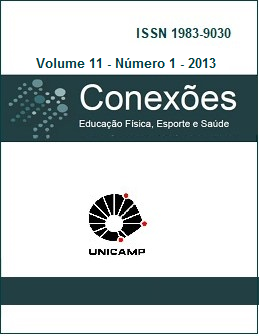Abstract
The main objective of this study was to evaluate anaerobic power developed by volleyball
players, as the role of game played (male n = 51; Edad15.43 ± 1.45 years, height 1.72 ±
0.08 meters, weight 64, 16 ± 10.17 kilograms, BMI, 21.65 ± 2.30, n = 37 women, age,
14.62 ± 1.65, height 1.64 ± 0.07 meters, 59.25 ± 7.03 kilograms weight, BMI, 21, 94 ±
2.60). Significant difference was detected in groups of stations with shipowners and libero
(p<0,005), respectively. The female group, there were no significant differences by role
playing (p<0,005). Therefore, the groups developed a higher peak power, have a better
relationship between force and speed developed for sport componene displacements.
References
KRAEMER, W.; HÄKKINEN,K. Treinamento de força para o esporte. Porto Alegre: Artmed, 2004.
MORAS, G. La preparación integral en el vóleibol. 2. ed. Barcelona: Paidotribo, 2000.
HESPANHOL, J. Avalação da resistência da força explosiva através de testes de saltos verticais. 2004. 121f. Tesis (Magister em Educação Física) - Faculdade de Educação Física, Univesidade Estadual de Campinas, Campinas, 2004.
RODACKI, L.; FOWLER, N.; BENNET, S. Multi-segment coordination: fatigues effects. Medicine and Science in Sport and Exercice, Hagerstown, v. 33, n.7, p. 157-167, 2001.
KERLINGER, F.; LEE, H. Investigación del comportamiento: métodos de investigación en ciencias sociales. 4. ed. México: McGraw-Hill, 2002.
SPENCER, M. et al. Physiological and metabolic responses of repeated-sprint activities: specific to field-based team sports. Sports Medicine, Auckland, v. 35, n. 3, p. 1025-1044, 2005.
SHEPPARD, J.; YOUNG, W. Agility literature review: classification, training and testinig. Journal Sport Sciences, London, v. 24, n.3, p. 919-932, 2006.
BAKER, J.; RAMSBOTTOM, R.; HAZELDINE, R. Maximal shuttle running over 40 m as a measure of anaerobic performance. British Journal of Sports Medicine, Loughborough, v. 27, n.4, p. 228-232, 1993.
BODDINGTON, M. K.; LAMBERT, M.I.; WALDECK, M. R. Validity of a 5-meter multiple shuttle run test for assessing fitness of women field hockey players. Journal Strength Condition Research, Colorado Springs, v.18, n.1, p. 97-100, 2004.
ZACHAROGIANNIS, E.; PARADISIS, G.; TZIORTZIS, S. An evaluation of tests of anaerobic power and capacity. Medicine and Science in Sports and Exercise, Hagerstown, v. 35, n. 5, p. 116-121, 2004.
GUTIÈRREZ G. Validación y confiabilidad del test anaeróbico de carreras para el vóleibol. 2012. 151f. Tesis (Magister en Ciencias de la Actividad Física y del Deporte) – Facultad de Ciencias de la Actividad Física, Universidad de Playa Ancha, Valparaiso, Chile, 2012.
NEWTON, R.; KRAEMER, W. Developing explosive muscular power: implications for a mixed methods training strategy. Journal of Strength and Conditioning Research, Colorado Springs, v. 16, n. 5, p. 20-29, 1994.
MAYHEW, J.; SCHWEGLER, T.; PIPER, F. Relationship of acceleration momentum to anaerobic power measurements. Journal Sport Medicine Physiology Fitness, v. 8, n. 26, p. 209-213, 1986.
JOHNSON, D; BAHAMODE, R. Power output estimate in university athletes. Journal of Strength and Conditioning Research, Colorado Springs, v. 10, n. 3, p. 161-166, 1996.
DE STE CROIX, M. et al. Changes in short-term power output in 10- to 12-year-olds. Journal of Sport Sciences, London, v.19, n.5, p. 141-148, 2001.
YANAGIVA, T. et al. Effect of gender on mechanical power output during repeated bouts of maximal running in trained teenagers. International Journal of Sport Medicine, v. 24, n. 6, p. 304-310, 2003.
SANTOS, A. et al. Optimal peak power in relation to age, body size, gender and thigh muscle. Pediatric Exercise Science, Champaign, v.15, n. 4, p. 406-418, 2003.
BRADLEY, L.; BALL, T. The Wingate Test: effect of load on the power outputs of female athletes and nonathltes. Journal of Applied Sport Science Research, v. 6, n.4, p. 193-199, 1992.
THARP, G. et al. Comparison of sprint and run times with performance on the Wingate Anaerobic Test. Research Quarterly for Exercise and Sport, Reston, v. 56, n.3, p. 73-76, 1995.
ESPER, A. Evaluación de todas las categorías de un Club de Vóleibol femenino con diferentes Test de capacidades Físicas. Revista Digital, Buenos Aires, v. 8, n. 57, feb. 2003 Disponible en : htpp// www.efdeportes.com. Aceso en: 10 jul. 2010.
HOFFMAN, J.; NUSSE, V.; KANG, J. The effect of an intercollegiate soccer game on maximal power performance. Canadian Journal of Applied Physiology, Champaign, v. 28, n.6, p. 807-817, 2003.
The Conexões: Educação Física, Esporte e Saúde Journal uses the license of Creative Commons (CC), thus preserving the integrity of articles in an open access environment.

